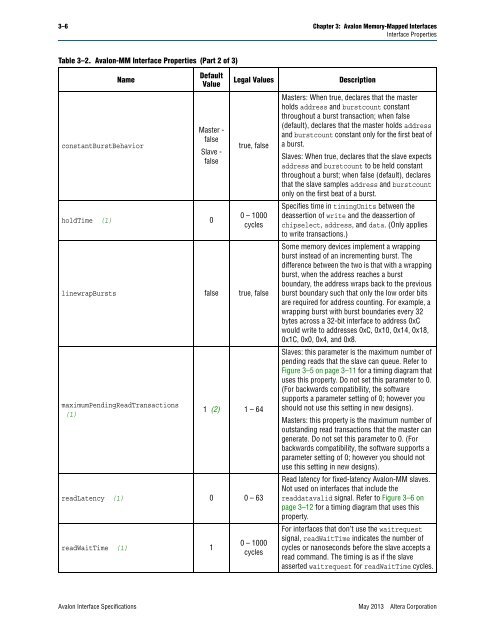Avalon Interface Specifications (PDF) - Altera
Avalon Interface Specifications (PDF) - Altera
Avalon Interface Specifications (PDF) - Altera
You also want an ePaper? Increase the reach of your titles
YUMPU automatically turns print PDFs into web optimized ePapers that Google loves.
3–6 Chapter 3: <strong>Avalon</strong> Memory-Mapped <strong>Interface</strong>s<br />
<strong>Interface</strong> Properties<br />
Table 3–2. <strong>Avalon</strong>-MM <strong>Interface</strong> Properties (Part 2 of 3)<br />
Name<br />
constantBurstBehavior<br />
Master -<br />
false<br />
Slave -<br />
false<br />
holdTime (1) 0<br />
true, false<br />
0 – 1000<br />
cycles<br />
linewrapBursts false true, false<br />
maximumPendingReadTransactions<br />
(1)<br />
Default<br />
Value<br />
1 (2) 1 – 64<br />
readLatency (1) 0 0 – 63<br />
readWaitTime (1) 1<br />
Legal Values Description<br />
0 – 1000<br />
cycles<br />
Masters: When true, declares that the master<br />
holds address and burstcount constant<br />
throughout a burst transaction; when false<br />
(default), declares that the master holds address<br />
and burstcount constant only for the first beat of<br />
a burst.<br />
Slaves: When true, declares that the slave expects<br />
address and burstcount to be held constant<br />
throughout a burst; when false (default), declares<br />
that the slave samples address and burstcount<br />
only on the first beat of a burst.<br />
Specifies time in timingUnits between the<br />
deassertion of write and the deassertion of<br />
chipselect, address, and data. (Only applies<br />
to write transactions.)<br />
Some memory devices implement a wrapping<br />
burst instead of an incrementing burst. The<br />
difference between the two is that with a wrapping<br />
burst, when the address reaches a burst<br />
boundary, the address wraps back to the previous<br />
burst boundary such that only the low order bits<br />
are required for address counting. For example, a<br />
wrapping burst with burst boundaries every 32<br />
bytes across a 32-bit interface to address 0xC<br />
would write to addresses 0xC, 0x10, 0x14, 0x18,<br />
0x1C, 0x0, 0x4, and 0x8.<br />
Slaves: this parameter is the maximum number of<br />
pending reads that the slave can queue. Refer to<br />
Figure 3–5 on page 3–11 for a timing diagram that<br />
uses this property. Do not set this parameter to 0.<br />
(For backwards compatibility, the software<br />
supports a parameter setting of 0; however you<br />
should not use this setting in new designs).<br />
Masters: this property is the maximum number of<br />
outstanding read transactions that the master can<br />
generate. Do not set this parameter to 0. (For<br />
backwards compatibility, the software supports a<br />
parameter setting of 0; however you should not<br />
use this setting in new designs).<br />
Read latency for fixed-latency <strong>Avalon</strong>-MM slaves.<br />
Not used on interfaces that include the<br />
readdatavalid signal. Refer to Figure 3–6 on<br />
page 3–12 for a timing diagram that uses this<br />
property.<br />
For interfaces that don’t use the waitrequest<br />
signal, readWaitTime indicates the number of<br />
cycles or nanoseconds before the slave accepts a<br />
read command. The timing is as if the slave<br />
asserted waitrequest for readWaitTime cycles.<br />
<strong>Avalon</strong> <strong>Interface</strong> <strong>Specifications</strong> May 2013 <strong>Altera</strong> Corporation
















